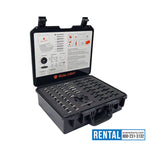You have no items in your shopping cart.
Setup to Show: Inside the Life of an Event Staging Crew

Such professional work is done before the lights go on and the music stops, before the host gets on the stage, and before a single visitor makes the entrance. These are those individuals who come in when no one is around, in the empty venue and convert the venue into a full-on spectacle. This is the world of stage setup services — and it’s more complex, coordinated, and crucial than most people ever realize.
This blog will go behind the curtain and spend a day with an event staging crew and point out the physical and technical elements involved in getting live events to work.
6:00 AM — Arrival and Load-In
In the majority of events, the staging department shows up way before the sun rises. Trailers full of staging, lighting, truss, sound, and video equipment start pulling into an empty place a parking lot, an open field, or an indoor venue that still resounds with empty spaces.
Each of the items of equipment is marked, counted and put in the right zone. The road cases roll in cascade like fashion with crew heads going over site maps, safety plans and schedules.
This is a preliminary segment that predetermines the whole process. Proper load-in is of great significance. Any hiccup at this point is transferred in the whole schedule and delays rehearsals, sound checking and even the time of starting the event.
7:00-10:00 AM- Construction of Stage Starts
The actual construction starts after the space has been freed, and materials ready. The stage setup services team typically starts with modular platforms — custom-sized, durable panels designed to snap together into a sturdy surface.
They use leveling tools, risers, as well as safety locks to build the backbone of the performance area. This may involve issues such as catwalks, multi-level risers, ADA compliant ramps, and so.
Stagehands do everything fast yet accurately where everything is stabilized and centered before one continues with it. In case of use of a custom stage design, the work will be even more elaborate as it requires curvy parts, clear glass wall panels, or even a thematic construction to get that specific image.
10:00 AM 12.00 PM -Rigging and Truss Systems
After the stage is stable, attention is directed towards the sky. Aluminum truss are made on ground and lifted to a position through crank towers or motorized chain hoists. Such trusses will carry lighting equipment, line array speakers, LED walls, banners, etc.
Rigging has to be spot on. Safety takes priority, because every trace of misaligned cable or unfixed fixture may become a dangerous nuisance. There is the verification and re-verification of every connection and signing before application of any power.
Technicians liaise with the lighting designers as well as the sound engineer in order to install the equipment at the location where it will be demanded. Sightlines, camera rigs and fire exits clearances are also undertaken by the crew.
12:00–1:00 PM — Crew Lunch (Fast and Focused)
Lunch is usually a sandwich in a handy nibble before some folding chairs or crates which are placed behind the stage. On board, crewmen replenish water, analyze their progress, and get ready to the more technical side of this day. Team communication is a necessity even during this brief pause in action as once the lunch is over it is system integration time.
1:00-4:00 PM-Audio, Lighting and the Visual Presentation Installation
Now it is time for the action to take place. Audio crews start airing speaker systems, laying wires and mounting microphones. The mixing consoles are wired and switched on. Line checks are done- mic by mic.
In the meantime, lighting techs put in moving heads, and LED pars, strobes, and blinders. These are hooked up to a central DMX control system and the cue programming of the performance commences.
There are LED video walls being raised, pixel mapped with accuracy, and supply data since the media servers fed it. Sponsor graphics, live graphics and camera feeds are tested and timed.
This is the phase where stage setup services blend physical setup with digital precision. The crew collaborates with the creative team, including the lighting designers, VJs, sound engineers to ensure technological applications reinforce the imaginations.
4:00 PM-6.00 PM-Rehearsals and Adjustments
As the gear is activated, the rehearsals are carried out. artists are tested on position, walk-throughs are executed and notes are made by the event producer.
And sometimes these last-minute changes are necessary: has to re-arrange a light in a better coverage position, it needs to adjust audio to it does not elicit feedback, it needs to alter the stage set-up to that which can accommodate choreography. The crew moves like lightning in the background and makes it all seem to be effortless.
6:00 PM — Showtime
At last the big moment comes. The lights in the house go down, music goes up, and audience cheers. The crew which was used to construct the event now moves to the backstage support, the job at hand simply checks the system, makes sure the settings are adjusted on-demand, and takes care of whatever comes in.
And when the spotlight is never on them, the event will definitely fail without their professionalism.
10:00 PM–2:00 AM — Strike and Load-Out
The crew is only picking up again when the last guest is gone. All that was brought up must now go all the way down, one thing after another as carefully, economically, as possible.
Strike commences with shutting down then dis-assembly, packing and re-loading equipment to trucks. Cables are coiled, floors are mopped and cases clicked closed. Load-out is commonly done at night, and majority of the crew members go away only when the venue is vacant again.
Why Stage Setup Services Matter
The people behind stage setup services are more than laborers — they are technicians, artists, and logisticians. Their services, besides the fact that an event appears and sounds fantastic, also assure safety, effectiveness, and stress-free events among the organizers and performers.
They have to put up with bad weather, changing schedules, technical difficulties, and physical fatigue but the show must go on.
Conclusion
Whenever you go to a concert, a conference or a festival, pause a while and thank the imperceptible crew at the back who made it all happen. Be it from the set up to the performance and well after the final applause, the staging team brings the magic.
Want to plan an event and need professional assistance? Trust the pros at EventStarts.com for full-service stage setup services that bring your vision to life — safely, efficiently, and flawlessly.





